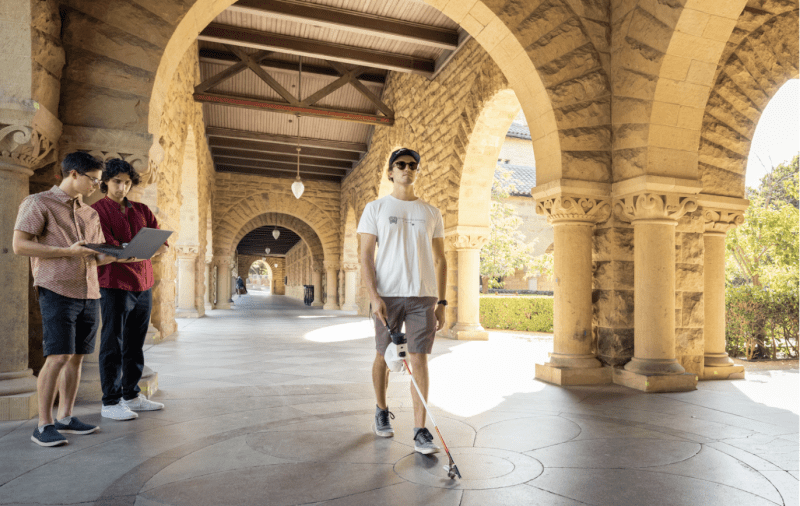Stanford researchers developed a smart cane to help the visually impaired navigate their surroundings. While the cane was designed to offer improvements over traditional white canes, questions surrounding its usability have surfaced.
The Augmented Cane is fitted with sensors that are commonly found in cell phones and self-driving cars. According to the study, these sensors consist of a two-dimensional light detection and ranging (LIDAR) system, a camera, a GPS and a device that measures acceleration and velocity.
The cane was developed in the lab of Mykel Kochenderfer, an associate professor of aeronautics and astronautics. Patrick Slade Ph.D. ’21, the lead author in the study and a former student of Kochenderfer, wrote that witnessing the work done in Kochenderfer’s lab made him realize that the same sensor and algorithmic work used in autonomous driving research could help people with impaired vision overcome similar navigation problems.
“A lot of my work is around human-robot systems so I’m always thinking about ways we can use robotics to assist people’s mobility,” Slade wrote in an email to The Daily.
According to Kochenderfer, the cost and usability of the Augmented Cane were the focus of the design. The Augmented Cane weighs two to three pounds and costs around $400 — considerably lighter and cheaper than many other smart canes, which can weigh anywhere from 12 to 50 pounds and cost as much as $6,000.
Bhavya Shah ’24, a fully blind mathematics and computer science sophomore at Stanford, said he thinks the cane is an interesting concept. Yet, while he appreciates the fact that the researchers “cared about scalability and driving down cost,” he said he is concerned that “the design may be based on a misconception about cane travel.”
According to Arjun Tambe ’19, the co-developer of the cane, the LIDAR is incorporated to sense a distanced obstacle and steer users away from the object.
However, Shah, who uses a white cane on a daily basis, explained that this feature could be counterproductive to cane travel. “When I hit an object, my cane makes a certain sound, and that’s precisely what its job is — for me to gain tactile and auditory information so that I know where I am based on the information,” he said.
Cricket X. Bidleman ’21 M.A. ’22, who is also fully blind, expressed similar concerns in an opinion piece published by The Daily in October. For her, the design of the cane raises questions about safety.
“What if the wheel gets stuck? What happens if there’s no power?” she asked during an interview.
Both Shah and Bidleman said that they have never tested the Augmented Cane themselves and could offer judgment only based on the description of its functionality in the study. Still, they believe that a lack of general cane training will be a major barrier to the adoption of this device.
“I think people need to learn how to use a white cane properly first before they can really talk about having a smart cane,” Bidleman said. According to her, the education for people with assistive technology is, in many cases, non-existent.
Shah, who grew up in India, had to undergo a formal cane training when he arrived in the U.S. He said that this training was necessary for him to gain confidence in using the cane, even when he has been a cane user for more than nine years.
While Bidleman acknowledged that “the developers clearly have the energy and desire to contribute to the disability community,” she said that “it would have been a better use of people’s time to try to figure out how to reimagine, or reform, the education that currently surrounds both assistive technology and orientation and mobility.”
The inclusion of disabled individuals in the development of assistive technology is an important aspect of any design process, as failing to include those with disabilities will likely result in unfounded assumptions about their needs and priorities, according to adjunct professor in chemical engineering John Moalli.
According to Moalli, able-bodied people tend to assume that the disabled want to be like them — an assumption that is then reflected in their design.
“If you’re designing something specifically for people with a disability, don’t succumb to ability bias,” he said. “Find out firsthand what their needs are before you even design the product.”
The cane development took into account feedback obtained from a survey conducted with visually-impaired research participants, according to Slade. The cane was then evaluated by emulating everyday activity on 12 vision-impaired individuals ranging from 20 to 80 years old. This co-design process ensures that they meet the users’ needs, he said.
“It was definitely a challenge to go through a lot of different iterations before arriving at something that actually felt useful and helpful,” Tambe said.
The cane developers said that the current version of the cane is a first step towards a future product. Still, more work is needed before it can be widely used. By publishing the design in an open-source platform, this development can be shared with a wider community, according to Kochenderfer.
“The beautiful thing is that people will take it and run with it in ways that are difficult for us as the original inventors to really predict,” he said.
This article has been corrected to reflect that Moalli said “don’t succumb to ability bias,” not “ability by us.” The Daily regrets this error.
